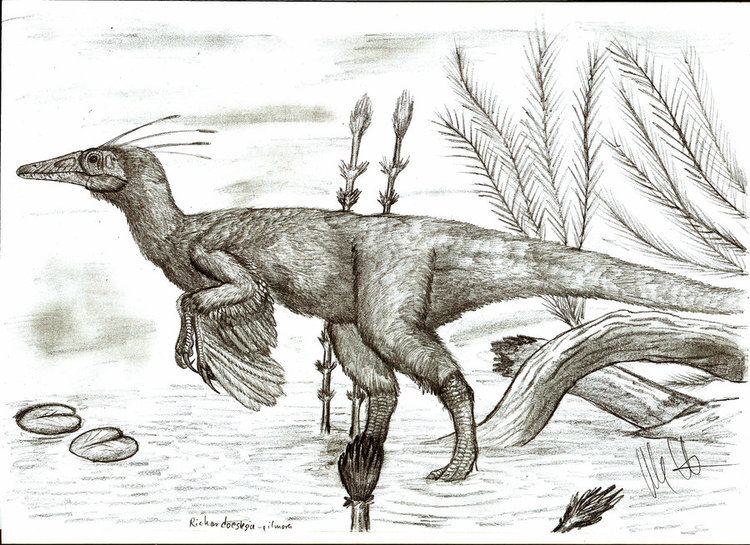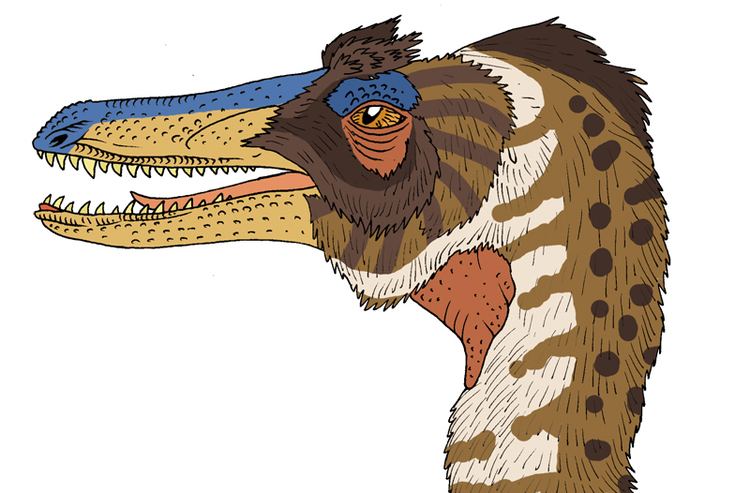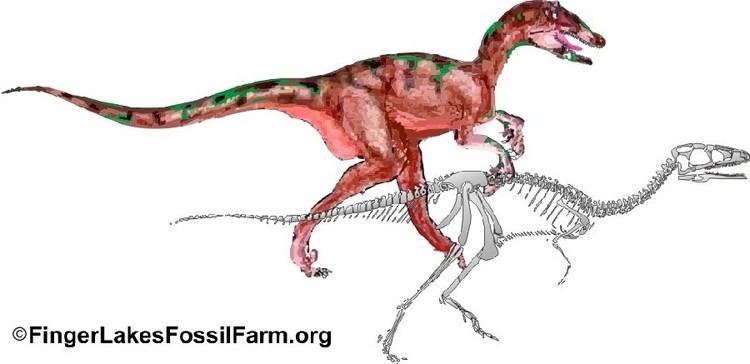Rank Genus | Class Reptilia Phylum Chordata | |
 | ||
Similar Paronychodon, Saurornitholestes, Parksosaurus, Sinornithoides, Nedcolbertia | ||
Richardoestesia is a medium-sized (~100 kg) genus of theropod dinosaur from the late Cretaceous Period of what is now North America. It currently contains two species, R. gilmorei and R. isosceles.
Contents

SpeciesEdit

The holotype specimen of Richardoestesia gilmorei (NMC 343) consists of the pair of lower jaws found in the upper Judith River Group, dating from the Campanian age, about 75 million years ago. The jaws are slender and rather long, 193 millimeter, but the teeth are small and very finely serrated with five to six denticles per millimeter. The serration density is a distinctive trait of the species.

In 2001, Julia Sankey named a second species: Richardoestesia isosceles, based on a tooth, LSUMGS 489:6238, from the Texan Aguja Formation, which is of a longer and less recurved type. The teeth of R. isosceles have also been identified as crocodyliform in shape, possibly belonging to a sebecosuchian.
History of studyEdit

The jaws were found in 1917 by Charles Hazelius Sternberg and sons in the Dinosaur Provincial Park in Alberta at the Little Sandhill Creek site. In 1924 Charles Whitney Gilmore named Chirostenotes pergracilis and referred the jaws to this species. In the eighties it became clear that Chirostenotes was an oviraptosaur to which the long jaws could not have belonged. Therefore in 1990 Phillip Currie, John Keith Rigby and Robert Evan Sloan named a separate species: Richardoestesia gilmorei. The genus is named for Richard Estes, to honor his important work on small vertebrates and especially theropod teeth of the Late Cretaceous. The naming authors actually intended to use the spelling Ricardoestesia, Ricardus being the normal latinisation of "Richard". However, except in one overlooked figure caption, the editors of the paper altered the spelling to include the 'h'.[1] Ironically, in 1991 George Olshevsky in a species list also used the spelling Richardoestesia, and indicated Ricardoestesia to be the misspelling, unaware that the original authors actually intended the name to be spelled this way. As a result, under ICZN rules, he acted as "first revisor" choosing between the two spelling variants of the original publication and inadvertently made the misspelt name official. Subsequently, the original authors have adopted the spelling Richardoestesia. The specific name honors Gilmore.
Age rangeEdit
Richardoestesia-like teeth have been found in many Late Cretaceous geological formations, including the Horseshoe Canyon Formation, the Scollard Formation, Hell Creek Formation, and the Lance Formation (dated to about 66 million years ago). Similar teeth have been referred to this genus from as early as the Barremian age (Cedar Mountain Formation, 125 million years ago).
Because of the disparity in location and time of the many referred teeth, researchers have cast doubt on the idea that they all belong to the same genus or species. A comparative study of the teeth published in 2013 demonstrated that both R. gilmorei and R. isosceles were only definitively present in the Dinosaur Park Formation, dated to between 76.5 and 75 million years ago. R. isosceles was also present in the Aguja Formation, roughly the same age. All other referred teeth most likely belong to different species, which have not been named due to the lack of body fossils for comparison.
